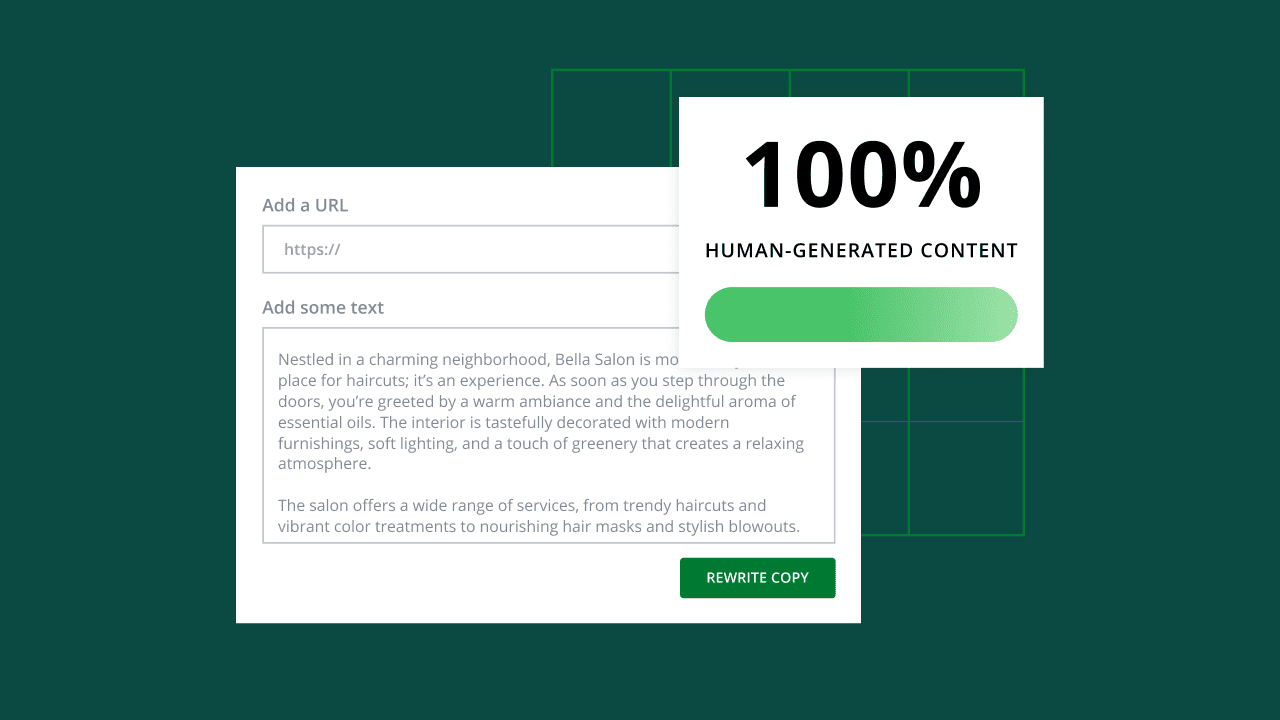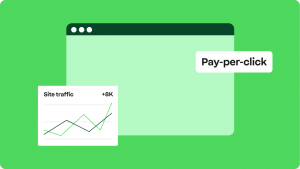Key takeaways:
- Gain insights into AI detection methods to maximize the potential of AI tools in content creation for a smooth workflow.
- Discover techniques for making AI-generated text indistinguishable from human writing.
- Use AI detection tools to pinpoint AI patterns in your text you can tweak to create human-like quality.
AI-assisted writing has become the norm. Whether it’s in school or at work, people are turning to AI tools to create content. It’s a fast and easy way to get your message across, but it isn’t perfect.
AI can be repetitive, inconsistent, and even generate “hallucinations”—details that sound convincing but aren’t actually true. If left unchecked, AI-generated content can affect the quality of your work and undermine brand trust.
To avoid that, we’ve laid out practical ways on how to make AI text undetectable so you can produce content that feels authentic, connects with readers, and stays true to the human voice.
How is AI-generated content detected?
AI writers like ChatGPT, Gemini, and Claude rely on human input and data to create content. They identify patterns, common expressions, phrases, or words and use them to generate writing that feels human-like.
However, because they’re limited by their programming, AI tools often leave behind recognizable patterns in their output. Here are a few of those telltale signs:
- Frequent use of stock phrases such as “crucial,” “it is important to note that,” “delve deeper,” or “ensure.”
- Heavy reliance on punctuation like dashes, semicolons, or other marks that people rarely use in everyday writing.
- Repeating ideas or overexplaining points until the content feels redundant.
- Writing that reads more like a press release than a natural conversation.
- Awkward grammar or complex sentence structures that don’t flow smoothly.
It might be difficult to spot these patterns at times, even for experienced writers. That’s why it helps to use AI detector tools to identify most of them and make your content easier to refine.
What are AI detector tools?
AI detection tools are programs designed to look for signs that a machine, not a human, created something. They do this by analyzing patterns in text, images, or audio. Most use natural language processing (NLP) and machine learning (ML) algorithms to spot these patterns.
The top AI detector tools include:
- TraceGPT. Known for its high accuracy, this tool excels at detecting AI-written text and is a solid pick if you want reliable results.
- Winston AI. With a user-friendly design and broad compatibility, it works seamlessly across platforms. It’s a good choice if you want to fit AI detection into your current workflow without much hassle.
- Hive. Offering a free AI detection tool, Hive is a great option for budget-conscious users. While it’s not the most advanced, it gets the job done for basic checks.
- GPTZero. Going beyond simple detection, this tool analyzes sentence structure and style. It’s beneficial if you’re trying to edit AI content to sound more natural and human.
- Originality.ai. This AI detection tool lets you adjust sensitivity based on your needs. It’s ideal for users who want more control over the detection process depending on the type of content they’re reviewing.
- Smodin. Providing unlimited checks at a low cost, it’s a practical choice for frequent users who want consistent, affordable access.
Just like AI content generators, these AI detection tools rely on patterns and probabilities. Since AI tends to write in predictable ways, detection tools are trained to flag content that looks too perfect or repetitive.
But here’s the catch: they’re not always right. That’s why simply changing a few words or rephrasing isn’t enough to beat the system. Instead, focus on making your content sound real. Add your own voice, opinions, and a more natural flow.
7 Ways to make AI content undetectable
Ready to create undetectable AI content that captivates readers? The secret is to master your AI content generator by using hyper-specific, detailed prompts. This gives you far more control over the raw AI-generated content it produces.
From there, a few simple edits are all it takes to make your writing sound genuinely human and authentic. Let’s look at seven ways you can do that:
- Rephrase and restructure your writing
- Use synonyms and natural language
- Add personal insights and perspectives
- Include accurate data and cite credible sources
- Use AI humanizer tools (with caution)
- Test and enhance your content
- Get a human editor involved
To give you a clearer image, we’ve discussed each method in the next sections.
1. Rephrase and restructure your writing
AI-generated writing can sometimes feel stiff and impersonal because these tools prioritize providing information over capturing a human-like touch.
If you use an AI content generator to organize your thoughts, polish its output by restructuring and rephrasing sentences. Think like a reader. Rearrange the thought sequences and use varied sentence lengths to make the text feel more natural.
As an example, let’s use ChatGPT’s response to the prompt “create a short paragraph about AI content”. Here’s how it appears without any edits:

As you can see, GPTZero dubs it as 100% AI generated. Here’s the updated version after rephrasing and restructuring:

The second version isn’t saying anything new—it’s the same idea rephrased. But by varying sentence lengths, softening the tone, and using simpler language, it reads less like a machine and more like human-written content.
2. Use synonyms and natural language
The more you use an AI tool, the more it adapts to your style of writing. Still, it often falls back on certain stock phrases that make text sound mechanical. Swapping these out for more natural alternatives is a simple way to make your content feel human.
These are phrases AI tools tend to overuse, along with more natural alternatives:
| Common AI Phrases/Terms | Alternative Phrases/Terms |
| Crucial | vital, important |
| Ensure | make sure, guarantee, confirm |
| Significant | notable, meaningful, major |
| Moreover | also, in addition, plus |
| Harness | use, employ, apply, utilize |
| Invaluable | very helpful, valuable, important, useful |
| Leverage | use, take advantage of, rely on, employ |
| Underscores | shows, highlights, emphasizes, confirms |
| Embark | begin, start, set out, launch |
| Intricate | complex, detailed, elaborate |
Simply swapping out words and phrases won’t always be enough to make AI text undetectable though. To really humanize your writing, combine this tip with other strategies.
3. Add personal insights and perspectives
Add your own experiences, viewpoints, or relatable examples. AI writing tools can’t reference lived experiences or real-world situations directly. Small details, anecdotes and imagery add a human element that will make your content easier to break down and connect to.
Let’s take ChatGPT’s take on shared hosting vs cloud hosting as an example:
Shared hosting involves multiple websites sharing the same physical server and its resources, making it a cost-effective but less flexible option, often suitable for small or personal websites. In contrast, cloud hosting uses a network of virtual servers that pull from a pool of physical machines, offering better performance, scalability, and reliability, ideal for growing or high-traffic websites.
While this gives you the answer upfront, someone trying to pinpoint the difference at a glance might still need to pause and break it down. Here’s how you could add a more creative and relatable spin:
Shared hosting is like a standalone gym. It operates alone. While there’s plenty of equipment to share, if it’s packed or if a machine breaks, you’re stuck dealing with what’s there. Cloud hosting, on the other hand, is like a franchise gym. You still share equipment at each branch, but if one location shuts down or you move, you can simply access another branch.

4. Include accurate data and cite credible sources
Information changes quickly, and it often takes weeks or even months before recent updates are officially published and spread across the web. AI writing tools can struggle to keep up with these shifts.
With varied sources and countless figures, sorting through information can be overwhelming, even for machines. This is where you can step in.
Add relevant statistics, findings, and your own insights to create more credible and authoritative content. You can use AI tools to help you add variation, but they often find it difficult to interpret or verify the accuracy of information.
Pro tip: If you’re using AI-generated content for data, always verify the figures and cross-check the references.
5. Use AI humanizer tools (with caution)
AI humanizer tools are designed to take your AI-written content and transform it into something that sounds like a person actually wrote it. Basic plans often do this by reorganizing the content to change its tone and mixing in more plain or natural language.
Here are a few humanizer tools you can use.
- Undetectable AI. An advanced AI humanizer that rewrites AI-generated content into natural, human-like text.
- Quillbot. A popular AI content rewriter that paraphrases and rephrases text to improve originality and reduce AI detection risk.
- Surfer AI Humanizer. This tool can help you rewrite AI-generated content into a humanized text that can pass AI content detection tools and search engines.
- ChatGPT Rewriter. You can use ChatGPT itself to rewrite AI generated text, which adds variation in sentence structure and vocabulary to bypass AI detection.
You’ll often see these tools marketed for speedy humanized content generation, but the truth is, they’re just as machine-driven as the AI writers themselves.
Simply copying and pasting AI text into an AI humanizer is not enough to create truly human text. Let’s take a look at this AI response and its “humanized version of the text.”

Quillbot’s AI Humanizer tool shows a side-by-side view of original AI-generated text and its resulting humanized conversion.
As shown in our example, AI humanizers are constrained by the input they receive. While the writing has changed, it still lacks the depth and warmth of a human voice.
That’s because a humanizer can’t add something to what isn’t there, like a completely new thought or powerful word to a dull section. That’s a human editor’s job.
6. Test and enhance your content
When transforming Ai-generated content, focus on creating a positive reader experience. To produce high quality work, take the time to draft and redraft your writing. Go through each sentence and see how they work with one another.
It helps to ask these questions when checking your AI-generated content.
- Does your writing sound like a real person talking?
- Is each sentence clear and easy to understand on its own?
- Have you used a mix of short, simple sentences and longer, more descriptive ones?
- Where can you remove unnecessary words to make your writing more concise?
- Does your work use engaging content?
- Do the ideas flow smoothly from one paragraph to the next?
If something feels off, you may need to tweak your ai generated content. To do that, read through your writing. If something is unclear, ask your AI tool to explain it further. Focus on writing like you speak and avoid jargon unless necessary.
Once you’re satisfied with your rewritten content, run it by an AI detector or ask friends and colleagues for their thoughts. If they’re able to put things together, you’re on the right track.
7. Get a human editor involved
To get truly human-like writing, you need a human editor. It’s especially important for PR professionals and digital marketers who use AI assistance—people whose jobs depend on getting strong reader engagement.
Even quick edits from a human can make a big difference. A fresh pair of eyes can catch awkward phrases and add the tone or rhythm that AI often misses. Think of it as the final polish that makes your work feel real.
Why should you make AI content undetectable?
Lots of people worry that Google will penalize their content just for being created by AI. But here’s the thing: Google has been clear that it doesn’t care how you create your content, as long as it’s credible, relevant, and high quality.
The real SEO risk is that unpolished AI-generated content is full of repetitive phrasing, misinformation, and disjointed texts. That can lead to a terrible user experience, a lack of trust in your brand, and ultimately, lower rankings in search results.
Making AI generated text undetectable isn’t about fooling a detector. It’s about adding a human touch to create something that provides true value. This makes your writing more authentic and engaging, which is exactly what both readers and search engines are looking for.
Common mistakes that make AI content detectable
Humanizing AI text is important, but that doesn’t mean you need to steer clear of AI for most of your content. To ensure you’re using these powerful tools responsibly, make sure you avoid these common behavioral pitfalls:
- Ignoring your reader’s experience. Always consider your audience. Think of who you’re writing for and adjust your tone and word usage accordingly.
- Using AI to create entire sections. AI is great at creating content, but it can’t fully grasp how human readers go through a piece. Always read, review, and polish the entire draft yourself.
- Accepting AI-generated stats and figures. AI tools are far from perfect when it comes to compiling accurate data. Double-check every statistic and figure against a credible source before publishing.
- Neglecting brand voice. AI tools might remember the tone you use, but only to a certain degree. Make sure the final content fully aligns with your unique, established brand voice and style.
- Not reorganizing AI-generated content. Sure, AI can present information logically, but its structure can be better. Read and reread to make sure the thoughts and ideas are presented well, making it easy for readers to process.
Ethical considerations when using AI content
AI tools can help you create content that sounds incredibly human. But with that power comes responsibility. The goal should always be to improve quality and save time—not to mislead. Here’s what to keep in mind when using AI ethically and transparently:
Be open about using AI
If you’re sharing content in a professional or public setting, letting people know that AI was involved is a good idea. Being upfront builds trust. For example, label any AI-generated sections in articles or reports. It shows honesty and helps avoid confusion later on.
Focus on quality, not deception
There’s a big difference between making content sound natural and trying to trick people. Use AI to make your writing more transparent, engaging, and easier to understand. But always keep your voice in the mix. The goal is to inform and connect—not to fool anyone.
Watch out for risks
Even with good intentions, AI content can raise serious concerns. Here are a few things to be aware of:
- Misinformation. AI can generate convincing fakes that are tough to spot. This makes it easy for false information to spread fast, and it can be hard to tell what’s real and what’s not.
- Loss of trust. When you rely too much on AI, it blurs the line between real and fake. If your audience finds out your content is just mass-produced, it can seriously hurt their trust in your brand.
- Manipulation. AI can generate messages that are used to scam people on a massive scale. With realistic fakes, it’s easier for bad actors to manipulate public opinion and cause harm.
- Legal issues. We’re still figuring out the legal rules around AI. There are many unanswered questions about who owns AI-generated work and who is held accountable if a machine causes harm.
- Privacy. AI tools can be used in ways that invade privacy. For example, deepfakes can create harmful content, and AI systems can analyze personal data on a massive scale.
- Bias. AI systems are trained on human-created data, which often contains real-world biases. This can cause AI to reflect and even amplify those biases, leading to unfair results.
That’s why creators, developers, and regulators all have a role to play. Setting clear rules, encouraging transparency, and teaching ethical use are key to making AI a helpful tool instead of a risky one.
What are the benefits of using AI content (when humanized)?
There’s a big payoff when you combine human input with AI. It’s about using the technology to your advantage to get a lot more done without losing quality.
- Speed and efficiency. Think of AI as your content-writing assistant. It can generate a first draft, an outline, or a summary in seconds. This saves you tons of time, so you can focus on making the writing great.
- Consistency and scalability. AI can quickly learn your brand’s voice and style. This means you can produce a large amount of content that sounds consistent and on-brand every time, making it easy to grow your content strategy.
- A stronger final product. When humans and AI work together, the result is better than what either could do alone. AI is great at speed and data, but a human provides the unique insights and creative judgment that truly connects with readers.
Final thoughts: How do you make AI content undetectable?
To sum up, the focus is on enhancing AI content with human creativity. Combining AI’s efficiency with your own perspective makes creating unique brand content that genuinely resonates easier.
And what better way can you effectively share this enhanced content with your audience? A website. Network Solutions’ website builder can help you build a website that reaches the right people.
Frequently asked questions
Not necessarily. Google prioritizes high-quality, helpful content that aligns with user intent. If your AI-assisted content meets these criteria, its origin becomes less relevant to search rankings.
Some plagiarism detection tools are evolving to identify AI-generated patterns. However, content that has been carefully edited for originality and incorporates unique human elements is considerably more challenging to flag.
While absolute certainty is difficult, a blend of thorough human editing, strategic rephrasing, and the injection of your personal voice significantly minimizes the likelihood of detection.
While AI detectors are always evolving, they primarily look for patterns in writing. When text is carefully paraphrased or humanized by a person, it becomes much more challenging for a detector to flag it as AI-generated.
The biggest risk is compromising on quality. Some tools may manipulate text by using simpler grammar or sacrificing accuracy just to evade detection. This can affect your credibility and lead to a poor user experience, which is a far more significant issue than being “undetectable” to a bot.
Yes, Google has sophisticated systems for this. However, their official stance is that they don’t penalize content simply because it’s created with AI. They’re more concerned with detecting low-quality, unhelpful, and spammy content.
Google’s systems look for telltale signs of low-quality content. This includes a lack of personal insight, repetitive phrasing, and factual inaccuracies.
The most effective strategy is to stop worrying about making the text “undetectable” and instead focus on making it genuinely helpful. Add your own expertise, unique perspective, and personal touch. When you edit and refine the content, you make it authentic and valuable to your readers.
You should avoid using AI for any content that demands a high level of accuracy, originality, or empathy. This includes things like legal documents, medical advice, academic research papers, or any deeply personal narrative. In these cases, the potential for error or loss of credibility is simply too high.
There isn’t a single “best” AI writer for everyone. The right tool really depends on your specific needs. Some are fantastic for short-form marketing copy, while others excel at generating long-form articles. The best tool is the one that fits seamlessly into your workflow and helps you produce high-quality, human-written content.




